There’s no doubt that a watermaker is one of the key pieces of equipment on the modern long-range cruiser. The Village Marine Little Wonder—one of the first high-output low-voltage watermakers—has done yeoman service on Calypso during her four years of cruising, and has largely freed us from the perpetual search for sources of fresh water.
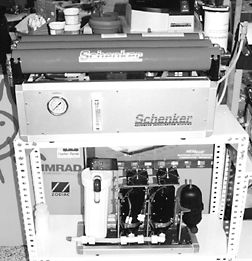
Since its introduction almost a decade ago, the Little Wonder has gone through significant upgrading to reduce power consumption, which historically has been a major consideration for low-voltage watermakers. The Spectra series of watermakers raised the stakes even higher with their ultra-efficient machines.
In the Canary Islands, we came across a relatively new low-voltage watermaker that is direct competition for the Spectra units—the Schenker watermaker. Although the name may sound German, Schenkers are actually made in Italy. These beautifully-packaged machines, available in either 12-volt or 24-volt configurations, are available with outputs of 35, 60, or 100 liters per hour. In American terms, that’s about 9, 16, and 26 gallons per hour. Electrical consumption is 110, 240, or 440 watts, which translates into 9, 20, or 37 amps per hour at 12 volts.
Obviously, for the largest unit, the engine or other charging source should be on to keep the battery voltage up when the machine is running, unless you have a very big battery bank. At 24 volts—increasingly the voltage of choice for larger cruising boats—amperage is halved. With a 12-volt system, each US gallon of fresh water eats only 1.25 amp hours of electricity, making the Schenker one of the most efficient low-voltage watermakers available.
Like the Spectra, Schenker uses off-the-shelf low-pressure pumps to power the watermaker. The smallest unit has a single pump, while the two larger systems feature dual pumps. With dual-pump systems, the failure of one of the pumps reduces output, but the unit will still function.
All models use standard 2521 reverse-osmosis membranes, available anywhere in the world.
Both rack and modular systems have been available in the past, but the company seems to be gearing more towards the modular systems, which can be fitted to smaller spaces. All the units are beautifully put together, and are easy to install.
We haven’t tested the Schenker watermakers, but we examined them carefully at Sunhine Maritime Ltd. in Gran Canaria. British-operated Sunshine Maritime is the UK distributor for Schenker, and has sold several machines to US owners. Prices in the Canaries range from about $3,900 to about $5,300. Shipping and duty would obviously push the cost higher on units shipped to the US. A number of accessories and options are available, including fresh-water backflush, ultraviolet sterilizers, and remote electronic controls.
If you’re thinking about a high-output low-voltage watermaker, this is one to look at.
Contact — Sunshine Maritime, Puerto de Mogan, Gran Canaria, Canary Islands, Spain Phone and fax: 34 928 56 54 74; www.schenker.it.
———-
Circuit Breaker/Battery Switch
There’s nothing terribly glamorous about a circuit breaker, although it’s an essential component of a boat’s electrical system. The same thing goes for a battery switch. Even so, Blue Sea Systems has introduced a combination switch and breaker in its T-1 series that offers a couple of slightly new twists that are worth mentioning.
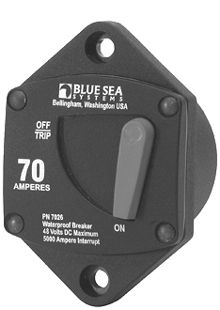
Essentially the T-1 unit is a small black box with a pair of screw terminals and a red lever on its face. The lever can be switched manually from the “On” to the “Off” position, or will trip automatically if there’s an overload. The position of the lever is easily visible from the face of the breaker. Nothing particularly unique so far, except that the lever is large, red, and unusually easy to see at a glance. Two factors, though, make the Blue Sea T-1 Series breakers different than others we’ve encountered: unusual compactness, and the fact that once tripped by a current overload they won’t reset until the fault is corrected, even if the lever is held in the “On” position. This would always be a positive feature in terms of electrical safety, although it’s easy to imagine times when you would want to risk a circuit overload for a few seconds in order to get something important done.
There are two models in the T-1 Series: One is for in-panel mounting, and the other is for surface mounting. The two are functionally identical, differing only in the position of the 5/16″ screw terminals and the mounting holes. Both are small: The 7100 series surface mount model measures roughly 3-1/2″ x 2-3/8″ and is 1-7/8″ deep, while the 7000 series panel mount is 3-3/8″ x 2-3/8″ x 2-1/2″ deep, protruding less than 3/4″ from the face of the panel. The panel version—which mounts in a 2-1/8″ round hole—carries its terminal posts on the back; the surface mount has them on the face. Both versions are vapor-proof (conforming to SAE J1171), making them safe for installation on gasoline-fueled boats.
They’ll handle up to 48 volts DC and come in a variety of amperage ratings, from 25 to 150. They list at $44.33, no matter which rating or which mounting style you choose.
———-
Squeegee This
If you find yourself spending an appreciable amount of time using a chamois cloth or squeegee on your boat—or anywhere else for that matter—you might consider the Quick-Dry Water Blade made by MPS Products (makers of the Swobbit Cleaning System). Like a conventional squeegee, it will eliminate water spots from a just-washed glossy surface. Unlike a squeegee, its wiping blade is flexible enough to handle curved and irregular surfaces.
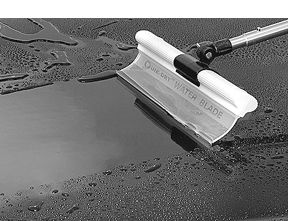
The Quick Dry consists of a single flexible silicone rubber blade—measuring 12″ wide and 2-1/2″ deep—mounted in a rigid molded plastic backing bar. The blade is about 1/8″ thick, with a 7/16″ wide “T” section at its outer edge, running the length of the blade. The “T” section does the actual wiping, while the flexible blade allows it to conform to a variety of shapes. You can use it as a handheld squeegee or attach it to a telescoping pole with an optional adapter.
MPS claims that the Quick-Dry will dry boats, enclosures and the like in a third of the time of chamois cloths and other squeegees. We can’t be sure of the numbers, but the Quick-Dry we tried did work quickly, and with very little effort.
The blade doesn’t tend to pick up bits of grit, so it should do well on glossy surfaces and polycarbonate. And, unlike the more conventional squeegee we compared it to, there are no metal parts to rust or corrode.
It’s not cheap: the Quick-Dry with adapter lists for $28.95. (The Quick-Dry alone would be $24.95.) On the other hand, it’s a well-made product that works well and seems like it should last a long time if it’s given decent care and not asked to stand in for a pry bar or a boat hook.
The manufacturer tells us that a smaller 10″ model and a larger 18″ model will be forthcoming.
Contact — MPS Products, Inc., 3065 Jupiter Park Circle , Suite #2, Jupiter, FL 33458, 800/362-9873.






























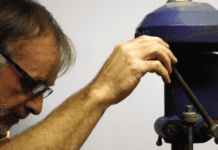
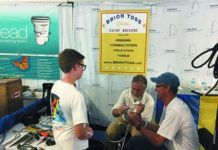




Enjoyed reading your post about the Schenker watermaker. My wife and I can gladly attest to the usefulness and efficiency of the model Zen 30 I installed last year aboard our Pretorien 35. Being tight for space, we actually removed one of our two 35-gallon tanks, to make room for the system. And so glad we did. Throughout cruising the Atlantic coast, then to Bermuda, Antigua and many other islands last winter, we eventually found ourselves quarantined in Culebra for two months before returning to New England in June. But we never once had to acquire water elsewhere. Always testing to under 250 tds, and making 7-8gph, using less than 9A @12V, this little machine is one we can’t consider doing without. For almost 14 months, we made water every 2-3 days, using solar power, and drank the water always straight from the tank. Now in the process of buying another boat, this unit will be the first upgrade on the list before setting out again!
-Chris & Kelly Jacques, SV Fayaway.